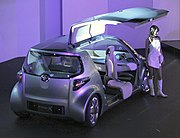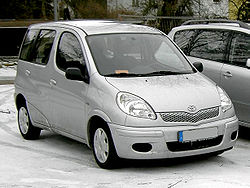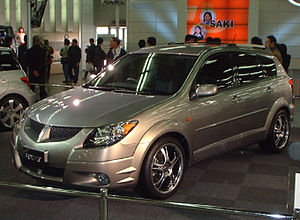
2005 Toyota Wish

2003 Toyota Wish JDM 2.0Z Model

2005 Toyota Wish JDM 2.0G Model
The Toyota Wish is a minivan produced by Japanese automaker Toyota since 2003. It is available as a six and seven-seater, equipped with either a 1.8 or 2.0-litre gasoline engine. It is positioned below the Ipsum and above the Spacio in Toyota's minivan range.
Apart from Japan, the Wish is also assembled in Thailand (for Thailand, Malaysia, and Singapore only) and Taiwan (for Taiwan only).
Model history
2003
The Wish was developed under code name "760N" by the team, lead by Chief engineer named Takeshi Yoshida and was introduced to the public for the first time at Tokyo Motor Show in October 2002 (Commercial vehicles & welcab show) and then launched in Japan in January,20th 2003, under a massive publicity campaign with Japanese singer Utada Hikaru. The TV commercial features her song Colors, which coincides with the launch of her new CD-single. The car was marketed under the "Wish Comes True" slogan.
Codenamed ZNE10G (FWD) and ZNE14G (4WD), it uses a 1.8 L 1ZZ-FE engine, producing (JIS) 132 PS and 170 N·m (125 ft·lbf). It is only available with four-speed automatic. A 2.0 L version (codenamed ANE11W for the six-seater version and ANE10G for the seven-seater version) was launched in April 2003. Equipped with the 1AZ-FSE direct-injection engine, it has (JIS) 155 PS (114 kW) and 192 N·m (142 ft·lbf). Variants with the 2.0 D-4 engine are only available with a CVT gearbox.
The WISH was extremely successful in its home market, and is frequently seen on the Top 5 on the 30 bestseller list each months. It has also made shockwave to its competitors, such as the Honda Stream & Madza Premacy or Mazda 5 to changing its market positioning. The Toyota Wish was also launched as a locally assembled model in Thailand towards the end of 2003 (Dec.2003). The Wish in Thailand is very similar to the Japanese version, except for a few differences:
- Models across the range get the 2.0Z fenders.
- Standard 17 inch wheels across the range (Same design as the one used on the 2.0Z)
- Same 2.0 1AZ-FE engine as the ASEAN Camry instead of the 1AZ-FSE
- No privacy glass (excluding the grey-import variants)
- Leather upholstery as standard on the 2.0Q
- The rear Double wishbone suspension of 4WD models in Japan was fitted with 2WD model in Thailand as standard.
(no Torsion beam rear suspension in Thai version).
2004
The Wish was launched in Taiwan in November 2004. For this market, the car is marketed under the "No Rules!" slogan and the TVCM is shot in New York. The Taiwanese version shares the same engine as the Thailand model, which means missing out on Toyota's D-4 technology. The Taiwanese assembled version have some styling differences: a new front end, redesigned rear LED taillights, reflectors recessed into the rear bumper, body color/chrome side rubbing strips and a cleaner chrome rear plate garnish. The WISH badging is not an integral part of the garnish, unlike the JDM-spec model. Equipment may include parking sensors, dual moonroof and leather seats. Another aspect unique to the Taiwanese Wish is that it can be specified with a beige interior color scheme unlike its Japanese and Thai-built counterparts.
2005
The car was a huge success in Japan, and featured in the best sellers chart regularly, no mean feat for an MPV. The Toyota Wish was updated at the end of 2005 with the introduction of a facelifted model. The original car was fundamentally well designed and that meant that few changes were necessary. Cosmetic changes to the headlights, bumpers, LED tail-lights and dashboard were made, together with revised switchgear for the climate control and automatic transmission (The 2.0Z received a seven-gear transmission. The 2005 Wish was also the third model to be sold exclusively through Toyota's NETZ dealer network, hence the replacement of the Wish's signature "W" front emblem with a generic NETZ oval (As seen on the 2005 Vitz & Ist.). Feedback on the electronic throttle control has been mixed, with claims that the original throttle system used in the 2003 car is quicker off the mark. The drivetrain and engines remained the same.















![Validate my RSS feed [Valid RSS]](valid-rss-rogers.png)














































































